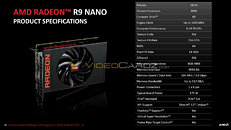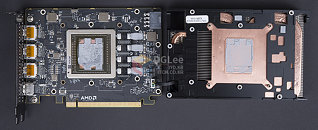Tuesday, August 25th 2015

AMD Radeon R9 Nano Core Configuration Detailed
AMD's upcoming mini-ITX friendly graphics card, the Radeon R9 Nano, which boasts of a typical board power of just 175W, is not a heavily stripped-down R9 Fury X, as was expected. The card will feature the full complement of GCN compute units physically present on the "Fiji" silicon, and in terms of specifications, is better loaded than even the R9 Fury. Specifications sheet of the R9 Nano leaked to the web, revealing that the card will feature all 4,096 stream processors physically present on the chip, along with 256 TMUs, and 64 ROPs. It will feature 4 GB of memory across the chip's 4096-bit HBM interface.
In terms of clock speeds, the R9 Nano isn't too far behind the R9 Fury X on paper - its core is clocked up to 1000 MHz, with its memory ticking at 500 MHz (512 GB/s). So how does it get down to 175W typical board power, from the 275W of the R9 Fury X? It's theorized that AMD could be using an aggressive power/temperature based clock-speed throttle. The resulting performance is 5-10% higher than the Radeon R9 290X, while never breaching a power target. Korean tech blog DGLee posted pictures of an R9 Nano taken apart. Its PCB is smaller than even that of the R9 Fury X, and makes do with a slimmer 4+2 phase VRM, than the 6+2 phase VRM found on the R9 Fury X.
Sources:
VideoCardz, IYD.kr
In terms of clock speeds, the R9 Nano isn't too far behind the R9 Fury X on paper - its core is clocked up to 1000 MHz, with its memory ticking at 500 MHz (512 GB/s). So how does it get down to 175W typical board power, from the 275W of the R9 Fury X? It's theorized that AMD could be using an aggressive power/temperature based clock-speed throttle. The resulting performance is 5-10% higher than the Radeon R9 290X, while never breaching a power target. Korean tech blog DGLee posted pictures of an R9 Nano taken apart. Its PCB is smaller than even that of the R9 Fury X, and makes do with a slimmer 4+2 phase VRM, than the 6+2 phase VRM found on the R9 Fury X.


101 Comments on AMD Radeon R9 Nano Core Configuration Detailed
Oh it's just the hype train making its rounds.
I do hope it’s a good card, for all our sakes, but till the benchmarks hit it’s just a pretty face.
But I do wonder what the temps/noise will be like. Seeing as the non X Fury got to 70C and it has a massive cooler.
What AMD has delivered is a very small card, that should reasonably approximate a much larger card sans overclocking. Honestly though, did anyone expect a card this small to somehow come in with insane overclocking? If they did, they were asking for something pretty crazy.
The card is interesting as a thought experiment. Move it to14nm, and HBM2 at 8 GB, and you'll have something truly amazing for the HTPC gaming crowd. As it stands now, meh. It'll be an expensive niche card that is great for someone needing a small form factor. Regular users won't allow the price premium, so it won't be something for the mainstream. I can see this card being amazing at 390 pricing, but it's not likely to be that reasonable.
As far as the AMD/NVIDIA debate, both companies are full of crap. AMD did do a rather hatchet job selling its current generation of GPU, but if you forgot the 970 debacle you're pure fanboy. Take everything with a grain of salt until it has been bench marked.
I'm not in the market for buying Nano, but I'm interested to see how efficient it is. It might even be more efficient than Maxwell considering that Fury (non-X) is already very close to Maxwell in power efficiency.
As for clocks, that's how the professional cards hit power limits, low clocks.
Given the stock Fiji chip being used, I guess some firmware is involved, unless there is PCB hardware for power limiting. If its hardware, no over clocking but if its firmware, it'll be flash happy. But risky....
If the Nano performs close to a 980 then efficiency is definitely good.
It means that overclocking for more performance scales rather poorly.
I haven't check if TPU have a subforum with funny stories. Your can quote me and post your answer there.
But yeah, Nvidia definitely told some lies and AMD lies sometimes and Publishers lie sometimes. It's a bit of a shady hobby we're in.